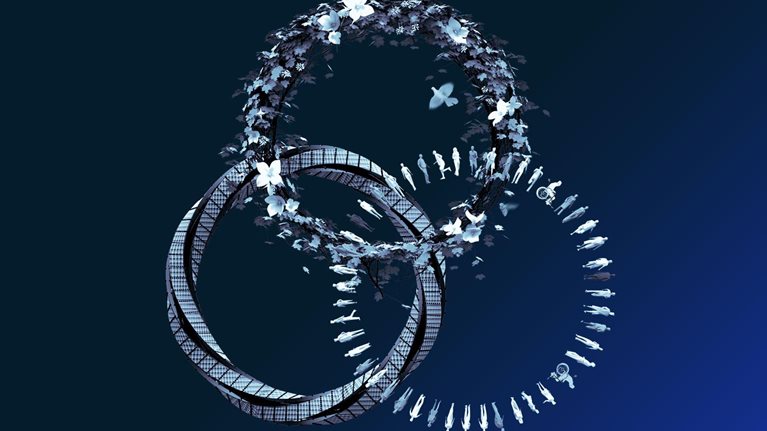In this edition of Author Talks, McKinsey Global Publishing’s Raju Narisetti chats with Giulio Boccaletti, honorary research associate at the Smith School of Enterprise and the Environment, University of Oxford, and a former McKinsey partner. In his new book, Water: A Biography (Pantheon, September 2021), Boccaletti traces the history of how human civilization has been shaped by its attempts to control water for economic and societal benefit. An edited version of the conversation follows.
Why is this book relevant now?
The story of water is a very long one, and the book covers enormous amounts of ground. But I felt that the last couple of years have really brought water up the totem pole of political discussions. Last summer, for example, we had catastrophic fires in the west of the United States. The Rhine and the Yellow River left their embankments. We’ve had catastrophic fires in Greece and Turkey. There have been events that have proven how salient water, or the absence of water, can be to people’s lives.
Something is changing. In part, the climate system is changing, but that’s not news to anybody. Also, the institutions and infrastructure that we built to protect us from water events are also beginning to fail with greater frequency. In a way, this is a good time to reflect on why that is, where those institutions come from, where that infrastructure comes from, and how we move forward. To understand that, we need to look back in time and understand how we got here.
Tell us something we didn’t know about water.
The book is an archaeology of ideas and facts about water. It goes all the way back to 10,000 years ago when we decided to stand still in a world of moving water. That’s when we became sedentary. There are many points at which, even in conducting the research for the book, I was so surprised by what I found, right from the very first fact—which is that the quantity of water on the planet has been effectively fixed since it first appeared 3.8 billion years ago. If you think about it, any sip of water that you take might have gone through the kidneys of some dinosaur at some point.
The relationship between water and society really took a turn when we became sedentary 10,000 years ago—when we decided to build our homes somewhere and manage a supply of water while protecting ourselves from having too much of it. From all the way then to the very important political and legal institutions that our lives depend on today—you know, the legal system itself, ideas of democracy and republic—these have all arisen not because of water but in a context where they are shaped by the hydrology, the kind of water, that happened to be in the Mediterranean at the point of origin.
The stories of globalization of the 19th and 20th centuries that we usually tell are stories of a consumption economy, and of a productive economy, and of goods and services traveling the world, but there’s a way in which you can trace the flow of water through all of them, even today. So the book is really a way of revealing the presence of water in almost every aspect of human life, up to the events of the Arab Spring and the great migrations that are currently happening in North Africa, in sub-Saharan Africa, and in Asia.
Security is a temporary illusion
Have we ever dealt smartly with water?
There are a few things to say about the question of whether there are examples from the past that really teach us something about how we should confront the future. The question of who has dealt best with water can only be answered in context. One of the main points of the book is to demonstrate that the way in which we deal with water is ultimately not a technical question. It’s a political question. At the heart of that is a question of values, and even in some ways of morals and ethics: what we care about and what we want our homes to look like.
You can’t answer the question of how best to deal with water if you don’t have a collective understanding of what a home needs to look like. You can’t say there’s an absolute sense in which some society in the past has best dealt with water issues. That said, one of the things that I got from examining the story of water for 10,000 years is that the variability, the variance, with which different societies engaged in this question of how to deliver water security is enormous compared with the relative homogeneity with which we deal with water today.
If you travel the world, from Japan to America to Italy, you know that we all stay dry, more or less, in the same way, through dams, reservoirs, canals. We’ve all engineered the landscape more or less in the same way, and that is the legacy of a very particular modernist project that started in the western United States in the 1920s. Up to that point, different societies in different parts of the world dealt with water in very, very different ways. One of the most interesting and kind of surprising ones was the way in which the civilizations of the Amazon dealt with water in the 1600s, before colonial projects of European imperial powers fully took hold, when they actually domesticated the entire environment. It was a full integration of an urban society within the forest, creating landscape like no other and one that we haven’t seen ever since. So in the past, there are a number of examples of societies that have dealt with water and the landscape in remarkably different ways than how we deal with it today. But the main lesson that we learned from all of them is not the technique and it’s not the engineering; it’s the fact that they wrestled with the politics of water, with where water fits at the heart of their political project.
Doesn’t water always and eventually win?
Water always wins because there’s a dynamic relationship where every time we take a step, the landscape and the climate system respond. For example, there may be a river that floods, like the Yellow River or the Rhine in Germany. Our first response is to build embankments and levees to try to contain the force of water. The result of that first step in engineering then is people moving under the shadows of those embankments and levees. They start building cities and farm them until, eventually, that solution fails. Some catastrophic event happens, inevitably, and we’re surprised and have to adjust and take another step in trying to control nature. And then nature responds again.
The point of the book is to alert readers to the fact that you never really solve these problems forever. The security that we’ve enjoyed for the past century is a temporary illusion. What we’re seeing around the world, from the fires in the west to the floods in Europe and in China, is that that illusion is breaking under the weight of climate change and under the changing conditions of institutions and infrastructure.
So how do you deal with water now?
That’s the question. Is there some magical silver bullet that we fire and solve it, once and for all? The answer, from 10,000 years of history, is no, that silver bullet doesn’t exist. The answer is a continuous cycle of adaptation and making sure that what we should do with our landscape is at the top of the public debate and at the heart of public discourse. This is not something you can delegate to several engineers wearing white coats in a backroom somewhere. This is at the heart of our civic contract. We have to all come together and come to some understanding of what we want our home to look like. Only that way can we both adjust to what’s coming next as well as accept the consequences of the choices that we make.
India seems to offer some optimism for you.
The book is actually, in some ways, a hopeful one. But it’s the hope of a realist. The story of India is a very good example. India has gone through an enormous transformation. The British first replumbed the country, particularly the Punjab region, turning the Indus River into the largest contiguous irrigation system in the world. It still is to this day—even through the subsequent independence and the tragedy of partition and the problems that happened between Pakistan and India. The interesting thing is that whilst most people worry about water wars, the Indus is a great example of the fact that two competing countries, two nuclear powers that have been to war three times in the past several decades, have still managed to cooperate on the Indus through the Indus Waters Treaty that was established in the 1960s.
So the story of water is much, much more often a story of cooperation rather than conflict. That doesn’t mean that conflict doesn’t happen. But in the end, human beings always find second-best solutions and institutional fixes to try and wrestle with this problem, maybe because it’s so important that you can’t hope to solve it with war. Maybe people just recognize that this is so existential that it can’t be left to a zero-sum-game conflict. So the story of India is a hopeful story, but one that’s tinged with realism.
There is no eternal solution in sight. But as long as countries and nations and institutions lift water out of the technical into the political and bring it into an arena of negotiation, the story of water, over and over again, shows us that cooperation is possible. That gives some hope, even in the face of the very significant problems that we face today.
In deep water
We don’t actually ‘see’ the full water picture, do we?
The book is an intent to reveal things that are hidden in history. But there are, of course, things that are hidden physically, and groundwater is possibly the most egregious example of that. Groundwater is where a significant amount of water resides today. It’s the storage infrastructure that nature has provided us. One of the best examples of how important the storage has been is the story of the Green Revolution in Punjab, in India, which transformed its ability to produce food on the bank of thousands, and hundreds of thousands, and eventually millions of bore wells that tapped into the groundwater of the Indus system.
One of the things that we’ve learned over the past ten, 15 years, particularly through the satellites that NASA put up in space to measure the gravitational force of the planet, is that many groundwater reservoirs are depleting rapidly. Of course, because they’re underground, they’re invisible. We don’t see them, and so people take no notice. But they’re like a bank account. We’re drawing money out of this bank account and we’re going into debt, and we don’t really pay attention.
The risk, of course, is that we don’t have any substitute for that bank account. Countries that haven’t invested in infrastructure at the surface—countries like India and Pakistan, but also the least-developed countries like Ethiopia and Angola, and others that depend on groundwater for their agricultural production—may be facing some very, very significant issues ahead. It’s important that water’s hidden; it’s hidden physically, it’s hidden institutionally, it’s hidden historically. One of the most important things we can do is bring it up to the surface and make sure that people pay attention.
It’s important that water’s hidden; it’s hidden physically, it’s hidden institutionally, it’s hidden historically. One of the most important things we can do is bring it up to the surface and make sure that people pay attention.
How you solve these issues is not a mystery. But if you don’t pay attention, you may be like Wile E. Coyote, where you fly off the ledge for several hundred meters before you realize you’ve overextended yourself, and then you’re in real trouble. That’s why I wanted to write this book—to give this sense of revelation, to make sure that people understand that there’s water everywhere, from institutions to underground, and to make sure that we pay attention. That’s the starting point for any solution.
You credit your McKinsey experience (2005–13) for influencing your water world.
McKinsey transformed my experience on water, literally. I had been a climate scientist before coming to the firm. I had a career in academia, and then I joined McKinsey somewhat naively thinking, “Oh, I’ll be talking to private-sector clients and public-sector clients all over the world about climate issues.” This was the early 2000s, and there wasn’t great interest in issues of climate in the way that we have today, but there was great interest in water. I found countless clients in food and beverage, friends in consumer companies—mining, oil and gas—extremely interested in the story of water and the question of how we wrestle with the problems of water scarcity and water availability.
As I started exploring this topic with many of them and with some of my great colleagues in the Sustainability Practice, which at the time actually didn’t exist—that came a little later—we discovered there was a great appetite to engage in this. In the end, with the help of the World Economic Forum and a number of McKinsey clients, we established a project, which is in the public domain, called the Water Resources Group, which still exists. It was about bringing analytic clarity to the problems of water scarcity around the world and lifting water up in economic and managerial terms to something that would be salient to CEOs. And we succeeded, so much so that we established a water service line and a water practice. It was a very happy time of my life.
The most important thing that I learned during my time at McKinsey, and in some ways that provides the roots for my interest in this book, is just how important raising the profile of the narrative on water was to making sure that people engaged at the right level. Our problem was to extract water from the bowels of technical concern and bring it up to the level of ministers and CEOs and decision makers. This book, 15 years later, is an attempt at continuing that journey to try and elevate the profile of water as I had done when I was at the firm, and as many of my colleagues continue to do. I also met some of my best water friends while I was at the firm. McKinsey was truly a transformative experience for me when it comes to my journey with water.
Watch the full video



